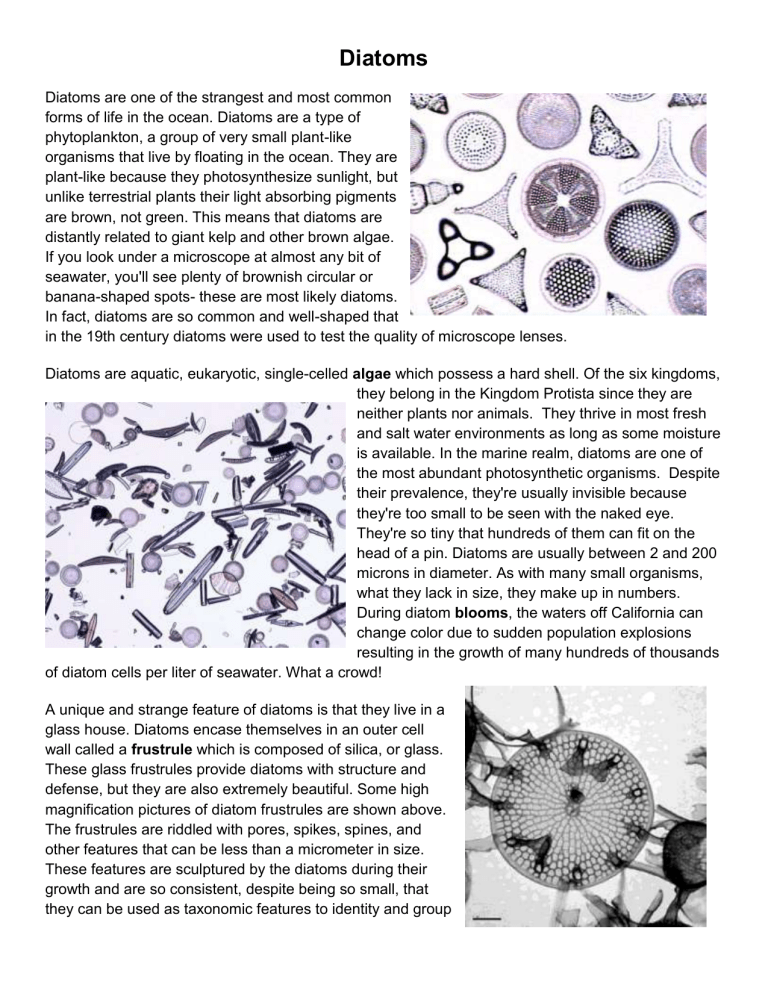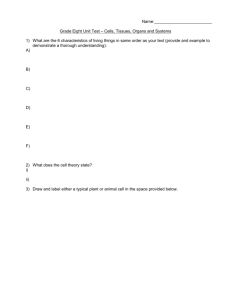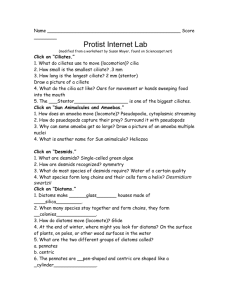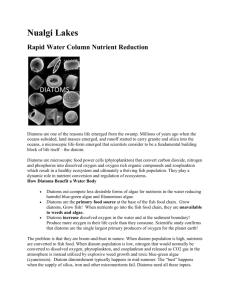Diatoms - MrsBurton

Diatoms
Diatoms are one of the strangest and most common forms of life in the ocean. Diatoms are a type of phytoplankton, a group of very small plant-like organisms that live by floating in the ocean. They are plant-like because they photosynthesize sunlight, but unlike terrestrial plants their light absorbing pigments are brown, not green. This means that diatoms are distantly related to giant kelp and other brown algae.
If you look under a microscope at almost any bit of seawater, you'll see plenty of brownish circular or banana-shaped spots- these are most likely diatoms.
In fact, diatoms are so common and well-shaped that in the 19th century diatoms were used to test the quality of microscope lenses.
Diatoms are aquatic, eukaryotic, single-celled algae which possess a hard shell. Of the six kingdoms, they belong in the Kingdom Protista since they are neither plants nor animals. They thrive in most fresh and salt water environments as long as some moisture is available. In the marine realm, diatoms are one of the most abundant photosynthetic organisms. Despite their prevalence, they're usually invisible because they're too small to be seen with the naked eye.
They're so tiny that hundreds of them can fit on the head of a pin. Diatoms are usually between 2 and 200 microns in diameter. As with many small organisms, what they lack in size, they make up in numbers.
During diatom blooms , the waters off California can change color due to sudden population explosions resulting in the growth of many hundreds of thousands of diatom cells per liter of seawater. What a crowd!
A unique and strange feature of diatoms is that they live in a glass house. Diatoms encase themselves in an outer cell wall called a frustrule which is composed of silica, or glass.
These glass frustrules provide diatoms with structure and defense, but they are also extremely beautiful. Some high magnification pictures of diatom frustrules are shown above.
The frustrules are riddled with pores, spikes, spines, and other features that can be less than a micrometer in size.
These features are sculptured by the diatoms during their growth and are so consistent, despite being so small, that they can be used as taxonomic features to identity and group
diatoms.
As floating phytoplankton, diatoms are faced with a classic question- do I sink or do I float? The beautiful frustrules are intimately tied to this question. The frustrule is heavy and therefore constantly pulls the diatom downward, though as photosynthesizers diatoms would rather be near the ocean surface and sunlight. Diatoms can counter their frustule weight by pumping light-weight ions into their cell vacuole (the underwater equivalent of inflating a helium balloon) to make themselves lighter and sink slower. Although a far step from active locomotion, this slight control over sinking rate can give diatoms the edge they need to stay near the sunlit ocean surface and survive in a variable and dynamic ocean. It's their way of weighting the die of survival in a chancy, turbulent ocean.
Diatoms may be extremely abundant in both freshwater and marine ecosystems; it is estimated that
20% to 25% of all organic carbon fixation on the planet (transformation of carbon dioxide and water into sugars, using light energy) is carried out by diatoms. This is possible because they contain chlorophyll.
Diatoms are thus a major food resource for marine and freshwater microorganisms and animal larvae, and are a major source of atmospheric oxygen.
Questions:
ANSWER THESE IN YOUR LAB NOTEBOOK ON THE NEXT AVAILABE PAGE USING
COMPLETE SENTENCES.
1. What do you think a “bloom” is based on the information given in this text?
2.
What is a “frustrule”?
3.
From the text, what do you think “chlorophyll” is used for?
4. Looking back at your bacteria notes and using this article, explain how bacteria and diatoms are different. Be sure to describe characteristics of both bacteria and diatoms.
5. What kingdom do diatoms belong in?
6. What are diatoms made of?
7. Where do diatoms live?
8. Describe the structures of diatoms.
9. Do diatoms skink or float?
10. Why are diatoms important?





